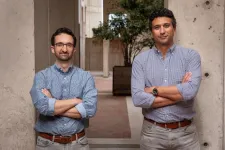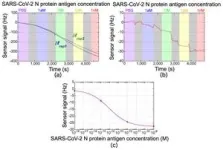(Press-News.org) LA JOLLA (September 26, 2023)—Movement offers a window into how the brain operates and controls the body. From clipboard-and-pen observation to modern artificial intelligence-based techniques, tracking human and animal movement has come a long way. Current cutting-edge methods utilize artificial intelligence to automatically track parts of the body as they move. However, training these models is still time-intensive and limited by the need for researchers to manually mark each body part hundreds to thousands of times.
Now, Associate Professor Eiman Azim and team have created GlowTrack, a non-invasive movement tracking method that uses fluorescent dye markers to train artificial intelligence. GlowTrack is robust, time-efficient, and high definition—capable of tracking a single digit on a mouse’s paw or hundreds of landmarks on a human hand.
The technique, published in Nature Communications on September 26, 2023, has applications spanning from biology to robotics to medicine and beyond.
“Over the last several years, there has been a revolution in tracking behavior as powerful artificial intelligence tools have been brought into the laboratory,” says Azim, senior author and holder of the William Scandling Developmental Chair. “Our approach makes these tools more versatile, improving the ways we capture diverse movements in the laboratory. Better quantification of movement gives us better insight into how the brain controls behavior and could aid in the study of movement disorders like amyotrophic lateral sclerosis (ALS) and Parkinson’s disease.”
Current methods to capture animal movement often require researchers to manually and repeatedly mark body parts on a computer screen—a time-consuming process subject to human error and time constraints. Human annotation means that these methods can usually only be used in a narrow testing environment, since artificial intelligence models specialize to the limited amount of training data they receive. For example, if the light, orientation of the animal’s body, camera angle, or any number of other factors were to change, the model would no longer recognize the tracked body part.
To address these limitations, the researchers used fluorescent dye to label parts of the animal or human body. With these “invisible” fluorescent dye markers, an enormous amount of visually diverse data can be created quickly and fed into the artificial intelligence models without the need for human annotation. Once fed this robust data, these models can be used to track movements across a much more diverse set of environments and at a resolution that would be far more difficult to achieve with manual human labeling.
This opens the door for easier comparison of movement data between studies, as different laboratories can use the same models to track body movement across a variety of situations. According to Azim, comparison and reproducibility of experiments are essential in the process of scientific discovery.
“Fluorescent dye markers were the perfect solution,” says first author Daniel Butler, a Salk bioinformatics analyst. Like the invisible ink on a dollar bill that lights up only when you want it to, our fluorescent dye markers can be turned on and off in the blink of an eye, allowing us to generate a massive amount of training data.”
In the future, the team is excited to support diverse applications of GlowTrack and pair its capabilities with other tracking tools that reconstruct movements in three dimensions, and with analysis approaches that can probe these vast movement datasets for patterns.
“Our approach can benefit a host of fields that need more sensitive, reliable, and comprehensive tools to capture and quantify movement,” says Azim. “I am eager to see how other scientists and non-scientists adopt these methods, and what unique, unforeseen applications might arise.”
Other authors include Alexander Keim and Shantanu Ray of Salk.
The work was supported by the UC San Diego CMG Training Program, a Jesse and Caryl Philips Foundation Award, the National Institutes of Health (R00NS088193, DP2NS105555, R01NS111479, RF1NS128898, and U19NS112959), the Searle Scholars Program, the Pew Charitable Trusts, and the McKnight Foundation.
About the Salk Institute for Biological Studies:
Unlocking the secrets of life itself is the driving force behind the Salk Institute. Our team of world-class, award-winning scientists pushes the boundaries of knowledge in areas such as neuroscience, cancer research, aging, immunobiology, plant biology, computational biology, and more. Founded by Jonas Salk, developer of the first safe and effective polio vaccine, the Institute is an independent, nonprofit research organization and architectural landmark: small by choice, intimate by nature, and fearless in the face of any challenge. Learn more at www.salk.edu.
END
Unleashing the power of AI to track animal behavior
Salk scientists create GlowTrack to track human and animal behavior with better resolution and more versatility
2023-09-26
ELSE PRESS RELEASES FROM THIS DATE:
Successful optical biosensing using dual optical combs: High sensitivity and rapid detection of biomolecules with promising prospects
2023-09-26
Key points
Biosensing has been valuable for detecting biomolecules, including novel coronavirus (SARS-CoV-2), but achieving both high sensitivity and rapidity has been challenging.
Rapid and high-sensitivity detection of SARS-CoV-2 was achieved by utilizing optical-to-electric frequency conversion of optical combs and active-dummy temperature compensation with dual-optical-comb configuration.
This enables ultra-early detection of infectious pathogens, health biomarkers, food contaminants, environmental hormones, and more, contributing to various preventive measures.
Research Introduction ...
New book spotlights sophisticated Indigenous responses to mining in the conflict-affected North Cauca region in Colombia
2023-09-26
Indigenous communities act in sophisticated ways to deter unauthorised mining in Colombia, shows a recently published book by Postdoctoral Researcher Diana Arbeláez-Ruiz from the University of Eastern Finland. The book focuses on Indigenous people and mining in Colombia’s North Cauca region, where multiple armed groups and illicit economies operate. The research the book is based upon was carried out in 2016–2019. As the illegal armed group presence and illicit economies situation in the region has intensified since, the book remains highly topical today.
Published by Routledge, the book documents what the Nasa Indigenous community do to stop unauthorised mining in their ...
Antarctica’s glacial border migrates for miles with the tide
2023-09-26
*Embargoed until 07:00 BST / 08:00 CEST, 26 September 2023*
The grounding line of the southern Ronne Ice Shelf in Antarctica can shift up to 15 km (six miles) with changing tides, new analysis shows. The research, published today in The Cryosphere, examines the key region where land-based Antarctic ice spills over into the surrounding ocean. Observing and understanding the dynamics of this region can help scientists predict Antarctica’s response to climate change, and so how much global sea levels will rise.
“We typically think of ice sheet change as being very slow, ...
Why endangered wildlife needs AML law coverage and banks need to share IWT intelligence
2023-09-26
The illegal wildlife trade (IWT) is a fast-growing ‘financial portfolio’ within the larger illegal, violent, parallel transnational global economy. As such, it creates state-level security and development risks, especially in source countries.
IWT is also known as wildlife trafficking, which includes the illicit trade of animals and plants, and derivative products such as pangolin scales, rhino horn, elephant ivory, lion and tiger bones, and leopard pelts.
But many highly developed countries signed up to CITES, are yet to implement a crucial legal instrument required to prosecute IWT and the associated financial ...
Why ecological restoration without Indigenous leadership won’t last
2023-09-26
Imagine you’re sitting in your living room on a quiet evening with your family reading a book, when suddenly, complete strangers let themselves in your front door. If that wasn’t enough of a shock, before you can even find your voice to ask who they are, they begin rearranging your furniture, painting your walls different colors, bagging up possessions that are important to you, and appear to be swapping out the food in your refrigerator.
They do not seem to mean you any harm and work with such purpose that you question yourself, wondering whether you may have forgotten ...
EWG study: Humans serve as sentinels for ‘forever chemicals’ harm to wildlife health
2023-09-26
WASHINGTON – A new paper by Environmental Working Group scientists proposes an intriguing concept: Humans can serve as a valuable resource for understanding the impact on other animal species of the toxic “forever chemicals” known as PFAS.
“PFAS pollution is not just a problem for humans,” said David Andrews, Ph.D., senior scientist at EWG. “It’s a problem for species across the globe. This new paper delves into how humans serve as an early warning system ...
How to save plants from climate change? Just ask them
2023-09-26
Redwoods and oaks that thrive on California’s coastline and coastal mountains might soon start finding it harder to survive. Human-caused climate change is altering the temperatures and rainfall patterns to which those and other trees are accustomed, and many have already been pushed close to the edge of what they can endure.
Identifying suitable new habitats will soon become a matter of life or death for some California native species, according to Lawren Sack, a UCLA professor of ecology and evolutionary biology. But if those trees could talk, where would they tell scientists they wanted to live?
In a new study, a team led by Sack and other UCLA biologists ...
Study finds senescent immune cells promote lung tumor growth
2023-09-26
ROCHESTER, Minn. — Macrophages are a type of white blood cell that are among the body's first line of defense against infection. In addition to killing harmful microorganisms, macrophages typically can initiate a response against tumors. However, macrophages, like other cells, can enter a state called senescence, which is linked to aging, disease and multiple physiological problems.
When cells become senescent, they stop dividing, but they do not die and are not always eliminated from the body. They can linger and accumulate in tissues and may ...
Study examines benefits and obstacles of library data storytelling
2023-09-26
The effective use of data storytelling could positively impact public library managers' approaches to data collection and their advocacy for libraries, according to Kate McDowell, associate professor in the School of Information Sciences at the University of Illinois Urbana-Champaign. However, cultural roadblocks to data storytelling must be addressed for the process to be successful, McDowell discovered in a recently completed study.
McDowell discusses her findings in the Public Library Quarterly article, "Library Data Storytelling: Obstacles and Paths Forward." This work is the result of her research project, "Data ...
Cost of living crisis set to cut UK lives short and significantly widen wealth-health gap
2023-09-26
The proportion of people dying before their time (under the age of 75) is set to rise by nearly 6.5%---30 extra deaths/100,000 of the population annually—with those in the most deprived households experiencing a rate 4 times that of the least deprived.
In recent years, the UK has experienced levels of inflation not seen since the 1970s as a result of the war in Ukraine, COVID-19, Brexit and fiscal policy, note the researchers. Poorer households have borne the brunt as they spend a larger proportion of their income on energy, the cost of which has soared.
In a bid to mitigate the impact, the UK government introduced a universal Energy Price Guarantee (EPG) and a series of more targeted ...
LAST 30 PRESS RELEASES:
Scientists trace microplastics in fertilizer from fields to the beach
The Lancet Obstetrics, Gynecology, & Women’s Health: Taking paracetamol during pregnancy does not increase risk of autism, ADHD or intellectual disabilities, confirms new gold-standard evidence review
Taking paracetamol during pregnancy does not increase risk of autism, ADHD or intellectual disabilities
Harm reduction vending machines in New York State expand access to overdose treatment and drug test strips, UB studies confirm
University of Phoenix releases white paper on Credit for Prior Learning as a catalyst for internal mobility and retention
Canada losing track of salmon health as climate and industrial threats mount
Molecular sieve-confined Pt-FeOx catalysts achieve highly efficient reversible hydrogen cycle of methylcyclohexane-toluene
Investment in farm productivity tools key to reducing greenhouse gas
New review highlights electrochemical pathways to recover uranium from wastewater and seawater
Hidden pollutants in shale gas development raise environmental concerns, new review finds
Discarded cigarette butts transformed into high performance energy storage materials
Researchers highlight role of alternative RNA splicing in schizophrenia
NTU Singapore scientists find new way to disarm antibiotic-resistant bacteria and restore healing in chronic wounds
Research suggests nationwide racial bias in media reporting on gun violence
Revealing the cell’s nanocourier at work
Health impacts of nursing home staffing
Public views about opioid overdose and people with opioid use disorder
Age-related changes in sperm DNA may play a role in autism risk
Ambitious model fails to explain near-death experiences, experts say
Multifaceted effects of inward foreign direct investment on new venture creation
Exploring mutations that spontaneously switch on a key brain cell receptor
Two-step genome editing enables the creation of full-length humanized mouse models
Pusan National University researchers develop light-activated tissue adhesive patch for rapid, watertight neurosurgical sealing
Study finds so-called super agers tend to have at least two key genetic advantages
Brain stimulation device cleared for ADHD in the US is overall safe but ineffective
Scientists discover natural ‘brake’ that could stop harmful inflammation
Tougher solid electrolyte advances long-sought lithium metal batteries
Experts provide policy roadmap to reduce dementia risk
New 3D imaging system could address limitations of MRI, CT and ultrasound
First-in-human drug trial lowers high blood fats
[Press-News.org] Unleashing the power of AI to track animal behaviorSalk scientists create GlowTrack to track human and animal behavior with better resolution and more versatility




